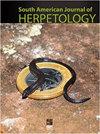巴西东南部棘足猴的性腺结构和生殖周期
IF 0.7
4区 生物学
Q4 ZOOLOGY
引用次数: 0
摘要
摘要2011年8月至2012年7月,我们在巴西东南部的大西洋森林研究了Bokermannohyla nanuzae的配子发生和繁殖。我们观察到青蛙几乎全年都有成熟的生殖细胞,这表明配子发生是持续的。然而,性腺晚期成熟发生在潮湿的月份,当我们观察到雌性产卵和雄性精子化时。我们观察到,在所有bimester中都有睾丸成熟的雄性,但只有在10月至1月才有精子。这种连续呼唤的模式可能与男性合唱中女性选择的男性策略有关。我们没有观察到睾丸静止的雄性或卵巢静止的雌性,全年我们观察到雄性所有发育阶段的生精细胞,以及不同成熟阶段的卵黄母细胞和雌性的几个排卵后卵泡,表明雄性和雌性都可能准备好对特定的环境线索做出反应,以释放它们的配子,甚至能够在一年中繁殖多次。这种繁殖的快速性可能是适应性的,因为当环境条件适合繁殖时,它可以让青蛙更快地达到成熟阶段,甚至在每个繁殖季节繁殖不止一次。本文章由计算机程序翻译,如有差异,请以英文原文为准。
Gonad Structure and Reproductive Cycle of Bokermannohyla nanuzae (Anura, Hylidae) in Southeastern Brazil
Abstract. We studied gametogenesis and reproduction of Bokermannohyla nanuzae at an Atlantic Forest site in southeastern Brazil from August 2011 to July 2012. We observed frogs with mature germ cells almost year-round, indicating continuous gametogenesis. However, advanced gonad maturation occurred in wet months, when we observed females spawning and spermiated males. We observed calling males with mature testes in all bimesters but spermiated males only from October to January. This pattern of continuous calling may be associated with male strategies to be selected by females within male choruses. We did not observe males with testes at rest or females with ovaries at rest, and throughout the year we observed spermatogenic cells in all developmental stages in males as well as vitellogenic oocytes in different maturation stages and several post-ovulatory follicles in females, indicating that both males and females may be ready to respond to a specific environmental cue to release their gametes or even be able to breed multiple times throughout the year. This promptness to breed may be adaptive as it allows frogs to reach mature stages faster when environmental conditions are suitable for breeding and even breed more than once per breeding season.
求助全文
通过发布文献求助,成功后即可免费获取论文全文。
去求助
来源期刊
CiteScore
1.50
自引率
0.00%
发文量
10
期刊介绍:
The South American Journal of Herpetology (SAJH) is an international journal published by the Brazilian Society of Herpetology that aims to provide an effective medium of communication for the international herpetological community. SAJH publishes peer-reviewed original contributions on all subjects related to the biology of amphibians and reptiles, including descriptive, comparative, inferential, and experimental studies and taxa from anywhere in the world, as well as theoretical studies that explore principles and methods.

 求助内容:
求助内容: 应助结果提醒方式:
应助结果提醒方式:


